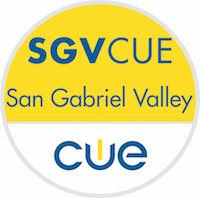Going BOLDY into our classrooms. CUE BOLD was this last weekend. This event showcased 21st-century classroom design, lesson design, and how lessons are woven together using good teaching, content, and technology to create the best learning experience possible. This whirlwind event was held in Lafayette, CA May 6-7 and showcased student-centered learning spaces with Erin Klein (@kleinerin of the Kleinspiration blog) and Ed Campos (@edcamosjr). Spaces were designed that allowed student movement around the classroom and were not confined to desks or a spot on the floor.
As the focus of the weekend was lesson design, the Madeleine Hunter 7-step lesson plan was used as a guide in building and showcasing lessons. The main focus were the 30-minute sessions. These fast-paced sessions took teachers through lessons using the 7-step lesson plan (goo.gl/hPPfo0.) Technology was intertwined throughout, but tools weren’t the focus. The focus was learning and the process, whether it was book reports (@annkozma723), writing (@cogswell_ben), vocabulary (your’s truly @herrplatt), hooking students throughout learning (@jmattmiller of ditchthattextbook.com), and STEM lesson design (@teachteKBeck) These lesson showcases emphasized how the 7 step planning process is necessary but how to use them in a 21st century setting: Anticipatory Set to Closure. What was brilliant to see throughout was that this process mustn’t be linear nor limited to a one-hour lesson. The steps may be moved around and even combined when necessary. Here’s a copy of the template used all weekend, courtesy of Jon Corippo (@jcorippo) – goo.gl/2006Sb.
The biggest opportunity throughout the day were the Lesson Builder Panels. These panels put three rockstar educators together in the same room to work with teachers to redesign and rebuild lessons using Madeleine Hunter’s process. The results were awesome: teachers working together and bouncing ideas off one another and collaborating to create a new lesson to inspire students to learn (examples: goo.gl/LD7aoD & goo.gl/Tq3Kk3).
So, what does the 7-step lesson plan include (goo.gl/uXlVPX)? Let’s see parts of a lesson in action for learning vocabulary.

Anticipatory Set:
Get the students hooked into learning. Start with checking their knowledge by running a Quizizz, Kahoot, Quizlet Live, Formative, Form, anything that can give you instant data and see where they are at. Gamifying it gets them connected and motivated.
Guided Practice:
Teacher directed practice. Take the vocabulary that students don’t know and use that as the focus for learning. Ideas:
-Put students into pairs and have them Pecha Kucha 3 different vocabulary words for 10 seconds each. Or use PechaFlickr and have students Pecha the pictures that come up based on the vocabulary they have to practice.
-Get students into groups of three and have them Iron Chef (goo.gl/ui6c01) the vocabulary. Each student gets a vocabulary word and uses the Frayer model to put together 1 slide on a vocabulary word. Give them 10 minutes to build the slide. All students present to the class with :30 seconds for each slide.
-Have students sketchnote the 4 main vocabulary words they don’t know and present that to the class. If they sketchnote with paper and pencil, take a photo and throw it into a Google Slide. If they use Paper53, screenshot it and throw it into a slidedeck.
Closure:
Regamify the learning. You don’t have to use the same tool but check to see if they improve their understanding of vocabulary after the guided practice. Did they improve from the baseline? The vocabulary they don’t understand, use as a focus for the next day and have students re-Pecha or Iron Chef the vocabulary again until they get it. The goal is to get them talking, using, and acting out the vocabulary daily. By the end of the week, the continuous practice will show itself and students will have proficiency in the vocabulary.
Final Thoughts:
In all, the weekend was amazing. This was a time to share, collaborate, network, and be inspired, especially during a time of year that both students and teachers are feeling the burn and strain of the last few weeks. I walked away with insight into what I am doing and how I can do it better to motivate my students and drive them forward to great things. Matt Miller, author of Ditch that Textbook, presented this weekend and had the following thoughts:
“It was really unlike any other conference I’ve been to, and I think it’s the direction that professional development needs to go. We need to get past the tool focus into application … how do all of these pieces fit together? To me, it was refreshing to see educators talking about lesson design instead of technology. Sure, tech played a big role, but it was all about meaningful implementation — and about collaboration. Everyone worked together, especially in those panel sessions. I know my view on how PD should be done was changed during BOLD.”
I eagerly await BOLD 18.
Blog Contributor

David Platt
Vice President



Recent Comments